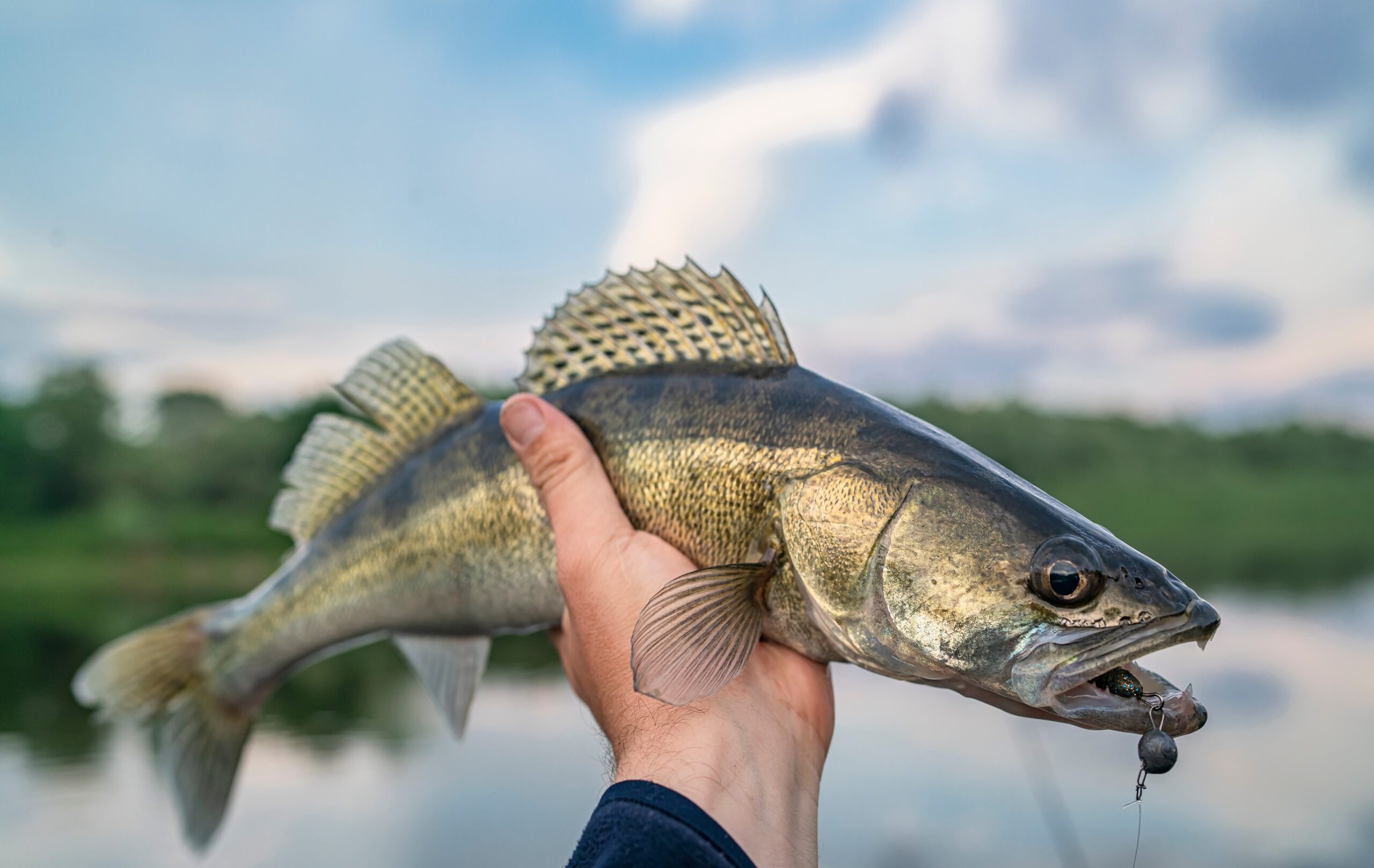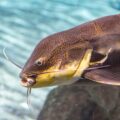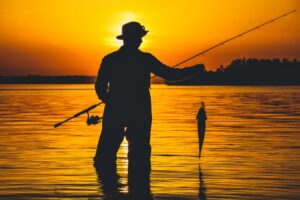Both catfish and walleye are freshwater fish. They differ in appearance, habitat, feeding habits, and taste. Both fish are prized for their meat and offer a challenging fight when hooked. However, despite some similarities in appearance, several key differences between these two species set them apart.
Although these fish may have some similarities, such as their freshwater habitats and popularity among anglers, their unique characteristics make understanding the differences between catfish and walleye important for both professional and novice fishermen.

Physical Appearance
Catfish are distinguished by their long, cylindrical bodies and whisker-like barbels around their mouths. They have flattened heads and wide, downward-facing mouths that help them feed on the bottom of water bodies.
Besides, catfish can differ in size depending on the species, with some reaching over 6 feet long and weighing hundreds of pounds. They generally have smooth, scaleless skin and are often colored in shades of brown, gray, and green.
Catfish are also known for their sharp, pointed spines on their dorsal and pectoral fins. These spines are used for defensive purposes and can be dangerous if mishandled.
On the other hand, walleye is known for their elongated, torpedo-shaped bodies and large, reflective eyes. They have a dorsal fin split into two separate sections: the front section contains spines, and the back contains soft rays.
Besides, walleye have pointed snouts and large mouths with sharp teeth, which they use to catch and swallow prey. They are generally colored in shades of olive and gold, with dark blotches on their sides.
Walleyes can vary in size depending on the location and habitat in which they live, but they can reach lengths of over 30 inches and weigh over 20 pounds.
Behavior
Catfish are naturally bottom-dwelling fish and are capable of eating from bottom-water bodies. They have a superior sense of smell and can detect their prey by scent, which they find with the use of their barbels.
Catfish are also recognized for their nocturnal behavior, and they are usually more active at night when they move into shallower areas to feed. During the day, they often hide in structures like logs, rocks, and vegetation.
Besides, many catfish species are also social and form groups, particularly during the breeding season. At the same time, some species are also known for their parental care, with adults guarding their eggs and frying them until they can fend for themselves.
On the other hand, walleye are active predators who can use their fantastic vision to find and catch prey. They are commonly found in deeper water during the day, moving towards the shallower areas at night to feed.
Walleyes are also known for their schooling behavior, with individuals gathering in groups during particular times of the year. They are also migratory and will move to different areas of a body of water depending on factors like water temperature and food availability.
During the spawning season, male walleye will stake out territories and protect them against other males. Females will then move into these territories to lay their eggs, fertilized by the males.
Habitat
Catfish are found in many freshwater habitats, such as rivers, lakes, and ponds. They prefer slow-moving or still water, and they are often found in areas with deep pools or structures like logs and rocks that provide them with cover and shelter.
Catfish are bottom-dwellers and are adapted to eating in murky water. They are known for surviving in low-oxygen environments and can be found in areas with low water flow and high levels of organic matter.
Many catfish species can also survive in brackish water, which means they can dwell in regions where freshwater and saltwater combine, such as beaches and coastal areas.
Walleye can also be found in large, clear, cold-water lakes and rivers. They like bottoms that are rocky or gravelly with medium-to-strong currents. They have also been seen gathering in areas with underwater vegetation that provides protection and attracts prey.
Walleye are temperature-sensitive and like water temperatures ranging from 60 to 70°F. They are susceptible to water quality and can find prey in clear water; therefore, they are commonly found in places with minimal turbidity.
Walleye are typically found in deeper water during the day and move into shallower areas at night to feed. Understanding the habitat preferences of catfish and walleye is vital for their conservation and management.
By protecting their habitats and managing their populations sustainably, we can help ensure these fish thrive in their natural environments for generations.
Dietary Preferences
Catfish have various diet habits, including insects, tiny fish, crabs, mollusks, and even plant material. Some species, like the channel catfish, prefer to consume live food, while other kinds, such as the blue catfish, have been observed feeding on dead fish and other organic materials.
Catfish are bottom feeders, meaning they can survive in murky water by using their barbels to sense their surroundings and seek food. Their big, powerful jaws and broad lips help them consume entire foods or smash hard-shelled creatures like crayfish.
Walleye, on the other hand, are primarily piscivores, which means they may eat other fish species. Small fish like perch, minnows, ciscoes, bugs, and other aquatic creatures constitute the majority of their food list.
Walleyes have outstanding vision and use their huge, reflecting eyes to find food in low-light settings. Their long bodies and keen teeth help them grab and consume food swiftly and effectively.
Taste
Catfish and walleye have unique flavor distinctions that are worth mentioning. Catfish is noted for its mild, sweet taste and solid structure, making it a popular ingredient in various seafood cuisines, such as fried catfish, catfish po’boys, and catfish gumbo.
However, they’re also popular in Cajun and Southern cuisine, where they’re seasoned with spicy rubs and served with classic sides like coleslaw and hush puppies. Walleye, on the other hand, has a soft, sweet taste that is generally described as meaty or flaky.
Additionally, their flesh is white and soft, with a similar feeling to that of trout or salmon. Because of this, they are a popular choice for grilling, baking, or frying, and they are often served with some basic spices like lemon and butter to accentuate their natural flavor.
Catfish and walleye can be served in different ways, and their flavor varies according to size, age, and nutrition. Catfish, on the other hand, has a richer taste than walleye.
Reproduction
Catfish are well-recognized for their unique reproductive rituals. Many catfish species use external fertilization, meaning the male discharges sperm straight into the water, and the female deposits her eggs in the same location.
Once fertilized, the eggs adhere to items in the water, such as pebbles or plants. Some catfish species, such as channel catfish and blue catfish, have a distinct reproductive activity known as nesting.
Male catfish construct nests by removing grass and debris from the bottom of a body of water and producing a tiny hollow. The female will lay her eggs in the nest, defended and aerated by the male until the eggs hatch.
On the other hand, the walleye reproduction process is similar to that of many other fish species. They are broadcast spawners, which means the female discharges her eggs directly into the water, and the male fertilizes the eggs with his sperm. This is most common in the spring when water temperatures rise 6–10 °C (42–50 °F).
Moreover, these fish typically spawn in shallow, rocky areas with average to fast currents. The eggs are sticky and stick to rocks or other structures until they hatch. After hatching, the walleye fry feed on zooplankton until they are large enough to eat small fish and other aquatic creatures.
Catfish and walleye are significant freshwater species, and understanding their reproductive processes is crucial for managing and preserving them. We can help guarantee that these fish populations remain healthy and prolific for future generations by conserving spawning habitats and implementing sustainable fishing methods.

What are the ecological roles of catfish and walleye in freshwater ecosystems?
Freshwater ecosystems are complicated and diverse, with many species playing important ecological roles. Two of these species are catfish and walleye, which are both essential predators in freshwater environments. Here’s a more detailed overview of the ecological roles of catfish and walleye in freshwater ecosystems:
Ecological Roles of Catfish
Bottom Dwellers
Catfish can eat food from the bottom of bodies of water and often use their barbels to find prey. They play a crucial role in the nutrient cycling of these environments because they feed on trash and other organic materials, breaking them down and recycling them back into the food chain. Catfish contribute to the decomposition process by consuming dead plant and animal debris, providing nutrients that may be utilized by other species.
Prey
Many catfish species are the primary food sources for larger predatory fish and birds. Flathead catfish, for example, is a significant prey species for bigger catfish and snapping turtles, but blue catfish is a favorite food item for bald eagles and ospreys.
Biodiversity
Catfish are a diverse category of fish; there are over 3,000 species found around the world. They are a crucial component of freshwater biodiversity and contribute to aquatic ecosystems’ general health and stability. Furthermore, several catfish species are vulnerable or endangered. Thus, it’s necessary to safeguard their populations and habitats.
Scavengers
Catfish are known for their opportunistic feeding habits. They eat dead or dying fish, crabs, and other aquatic creatures. This helps eliminate dead or decaying material from the environment by lowering the risk of illness and reducing water quality.
Ecological Roles of Walleye
Predators
Walleye are energetic predators that eat a wide range of food, including tiny fish, crabs, and insects. They play a crucial role in managing these creatures’ numbers, which can harm the food chain.
Moreover, walleyes can help maintain the overall balance of the environment by controlling the population of smaller prey species. They can also assist in preventing overgrazing and other detrimental consequences.
Biodiversity
Walleye are a worthy game fish that recreational fishermen frequently pursue. They are an essential part of freshwater biodiversity by contributing to the general health and stability of aquatic ecosystems.
In addition, any changes in their numbers and distribution serve as indicators of environmental change, and any variations in their numbers or distribution indicate that the environment is changing.
Top-Down Control
Walleye, as top predators, play a vital role in regulating the populations of other fish species. There may be adverse effects on other species across the food chain if the number of walleye changes.
Migration
Walleye are also migratory; they move to various locations according to variables such as water temperature and food availability. This mobility helps distribute nutrients and energy across the environment, allowing other creatures to survive and flourish.
Conclusion
Finally, as catfish and walleye share some standard features, such as their freshwater environment, they are two species of fish with distinct morphological, behavioral, and nutritional characteristics.
Understanding the distinctions between these two fish species may benefit anglers trying to target a specific type of fish and those curious about the vast and exciting world of freshwater fish.
Whether you enjoy catching catfish or walleye, remember that both are vital members of their ecosystems. We can ensure that these fish populations remain healthy and prolific for future generations by using catch-and-release fishing techniques.











